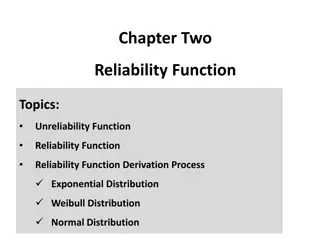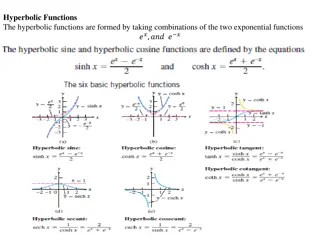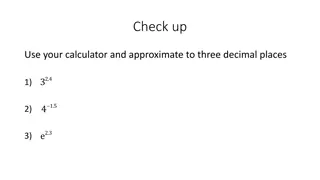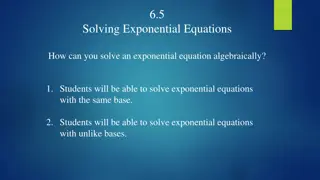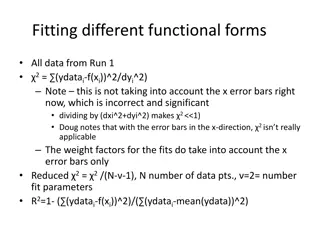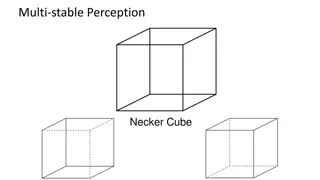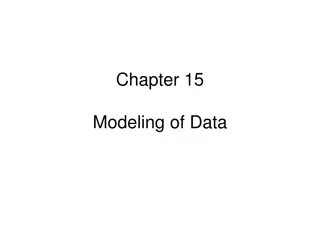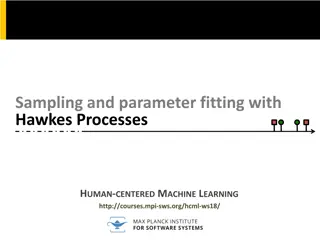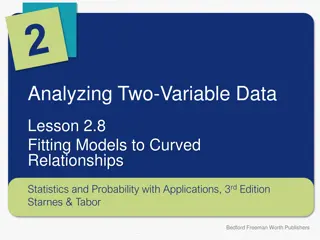Fitting Exponential Functions to Data: Examples and Applications
Understanding how to fit exponential functions to data is essential for analyzing non-linear relationships. This presentation explores the process of fitting exponential functions using examples from population growth data, discussing characteristics and interpreting results. It also introduces the concept of the base e and explains how to handle exponential decay factors. Practical demonstrations on TI calculators and Excel are provided throughout the slides.
Download Presentation

Please find below an Image/Link to download the presentation.
The content on the website is provided AS IS for your information and personal use only. It may not be sold, licensed, or shared on other websites without obtaining consent from the author.If you encounter any issues during the download, it is possible that the publisher has removed the file from their server.
You are allowed to download the files provided on this website for personal or commercial use, subject to the condition that they are used lawfully. All files are the property of their respective owners.
The content on the website is provided AS IS for your information and personal use only. It may not be sold, licensed, or shared on other websites without obtaining consent from the author.
E N D
Presentation Transcript
Fitting Exponential Functions to Data All slides in this presentations are based on the book Functions, Data and Models, S.P. Gordon and F. S Gordon ISBN 978-0-88385-767-0
Fitting Data to An Exponential Function Although Linear Regression is a powerful tool, not all relationships between two quantities are linear. (See scatterplots in figure 5.28) Scatterplots suggest an exponential pattern, so we need to fit data to an exponential function (Using TI 83/84 Calculators) p. 2
How to do Exponential Regressions on TI Calculator Example 1 The population of the United States , in millions, in the decades from 1780 to 1900 is shown in Table 5.1 on the right. Find an exponential function that fits these data and discuss its characteristics. 1. Create a scatterplot ` e S @ EDIT Make sure the rest of the screen looks like this Adjust window (Why these values?) % p. 3
How to do Exponential Regressions on TI Calculator 2. Determine the equation Enter the equation 0 e S e ! % ? = ? ? = 3.071 1.322? The growth factor, 1.322, indicates the U.S. population grew at a rate of 32.2% per decade from 1780 to 1900. The curve fits the data very well, so the exponential function is a good fit to the population data from 1780 to 1900 p. 4
The Base e Had we solved the previous problem in excel, the graph would have looked identical, but the equation would have looked different. In Excel U.S. Population Growth Pop. Millions) 100 90 80 y = 3.0712e0.2791x 70 60 50 40 30 20 10 0 0 2 4 6 8 10 12 14 time (Decades) Excel uses a special base denoted by e; it stands for the irrational number e = 2.71828 p. 5
The Base e continued ? = 3.071 ?0.2791 ? Here s the equation from the previous slide: ? = 3.071 2.718280.2791 ? Using the definition of e we get: ? = 3.071 (2.718280.2791)? Using the law of exponents we get: ? = 3.071 (1.322)? Raising 2.71828 to the 0.2791 power Now compare to our original answer ? = ? ? = 3.071 1.322? p. 6
The Base e with a negative exponent Example ? = 100 ? 1.025 ? ? 100 (2.71828 1.025)? ? 100 (0.3588)? The exponential decay factor is approximately 0.3588 so the decay rate = 1 0.3588 = .6412 p. 7
Exponential Decay Example (Solution Part A) % ` e S @ EDIT Make sure the rest of the screen looks like this Shape of exponential decay Adjust window (Why these values?) Enter the equation 0 S ! % e e p. 9
Exponential Decay Example (Solution Part A) The exponential decay factor is approximately 0.9909 so the decay rate = 1 0.9909 = .0091 so the level of L- Dopa decreases by almost 1% every minute. The model fits the data very well, especially after the first two points. p. 10
Exponential Decay Solution Part B ? ? = 2147.9 0.9909? Let t = 200 ? 200 = 2147.9 0.9909200 345.1 ????????? ??? ?????????? p. 11
Exponential Decay Solution Part C ? ? = 2147.9 0.9909? Let t = 8 * 60 = 480 (Why?) ? 480 = 2147.9 0.9909480 26.7 ????????? ??? ?????????? p. 12
Exponential Decay Solution Part D ? ? = 2147.9 0.9909? We now know the value of L(t) and are looking for the value of t 100 2147.9= 0.9909? 100 = 2147.9 0.9909? ?? Use logs to solve for t 100 2147.9 100 2147.9 = ??(0.9909)? so ?? ?? = ? ??(0.9909) so ???.? = ? The L-Dopa level will be down to 100 nanograms per milliliter in approximately 335 minutes or slightly more than 3 and one-half hours. p. 13
Example 3 Solution Part A S 0 e S EDIT e Numbers are too large for the calculator to handle. p. 15
Example 3 Solution Part B Years since 1990 Cell Phone Users 90 5.3 92 11 93 16 94 24.1 95 33.8 96 44 97 55.3 98 69.2 99 86 100 109.5 e S 0 S e EDIT ? ? = 1.264 10 11 1.349? Growth Factor = 1.349 Growth Rate = 34.9% p. 16
Example 3 Solution Part C Years since 1990 Cell Phone Users 0 2 11 3 16 4 5 6 44 7 8 9 86 10 110 5.3 24.1 33.8 55.3 69.2 S 0 e S EDIT e ? ? = .395 1.349? Notice the parameter A is much more manageable in this model compared to the solution in Part B p. 17


